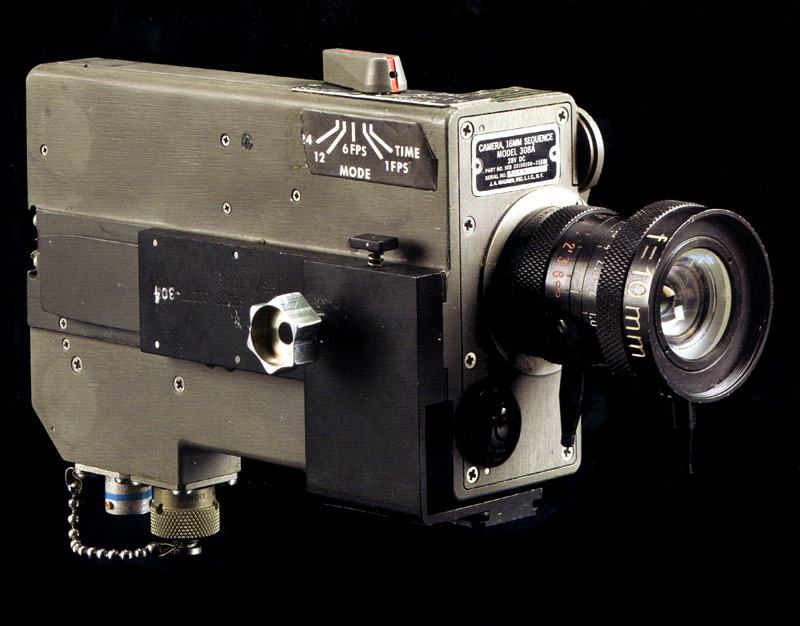Who Owns the Moon Camera? U.S. Government vs. Apollo Astronaut

If the government throws a camera away on the moon and an astronaut then picks it up and saves it, does it become his to own and sell?
That's more or less the question to which the U.S. government is seeking a federal court answer in the case "United States of America vs. Edgar Mitchell," which was filed in Miami last Wednesday (June 29).
The lawsuit, which names the sixth man to walk on the moon as the defendant, asks the court to declare a movie camera that was used during the 1971 Apollo 14 mission as the "exclusive property of the United States."
After returning to Earth with the camera and having it in his possession for the past four decades, Mitchell, 80, attempted to sell it last month through a New York auction house. The camera, which was estimated to sell for between $60,000 and $80,000, was withdrawn before its sale could proceed.
According to the lawsuit, which was filed by Asst. U.S. Attorney Christopher Macchiaroli on behalf of NASA, the government made "multiple requests" for Mitchell to return the camera "and no response [was] provided."
From the moon to the Earth
To understand why the camera's ownership is now being contested, one must first appreciate how it ended up back on Earth.
Breaking space news, the latest updates on rocket launches, skywatching events and more!
The 6-inch long by 4-inch high by 2-inch thick (15 by 10 by 5 cm) Data Acquisition Camera (DAC) was one of two 16 mm motion picture cameras aboard the Apollo 14 lunar module "Antares" when it landed on the moon on Feb. 5, 1971. Used to record engineering data, terrain and lunar surface photography, this particular camera was mounted inside, looking out the right window on Mitchell's side of the lander. [Top 10 Apollo Hoax Theories]
The camera shot the final five minutes of Antares' landing, as Mitchell's crewmate, commander Alan Shepard, piloted the spacecraft to a touchdown on the moon's Fra Mauro Highlands.
After more than 33 hours on the surface, including two moon walks and a couple of swings with a makeshift golf club, Shepard and Mitchell blasted off the moon, the camera still on board.
The mission plan called for the DAC to be left in Antares to save weight aboard the command module "Kitty Hawk," the capsule that would return the astronauts to Earth. The lunar module and all its contents would be left to slam back onto the moon just a day later.
Mitchell however, had other plans. In addition to various other spacesuit and spacecraft hardware that Shepard and he saved from being smashed to smithereens, Mitchell moved the camera to the command module for the ride home.
"In addition to taking the data out of it, the tape, I brought the camera itself back too," Mitchell told WPTV, the NBC-Affiliate near his home in Palm Beach, Fla.
Mission mementos
The Apollo 14 astronauts were not the only crewmates to salvage parts of their lunar module as mementos. Almost all the others did the same.
The Apollo 13 crew was instructed by Mission Control to salvage spare parts from that mission's moon lander. A mid-flight explosion famously ended in the moon landing being canceled, and the landing module's mementos helped compensate for the missing weight that was to have been made up by moon rocks.
But a problem was not necessary for others to bring home unplanned souvenirs.
Astronauts aboard Apollo 12 and Apollo 15 ripped off parts of their moonwalking suits' life support backpacks before they were discarded onto the lunar surface. Others saved their module's joystick hand controllers, as well as netting used to restrain equipment and support cables.
NASA didn't need these makeshift mementos to return to Earth. In some cases, such as the camera brought back by Mitchell, the agency's plan was to have it deposited at the bottom of an impact crater created when the moon lander crashed down onto the moon's surface.
Just the same, the astronauts asked their bosses at the Manned Spacecraft Center — now called the Johnson Space Center — in Houston for permission to keep the items they returned, along with other souvenirs such as their personal hygiene kits and the checklists they followed to navigate to and from the moon.
"We had an agreement with NASA management, that small items that didn't exceed our weight limitations, we could bring back," Mitchell told WPTV.
A few memos reside today in the NASA history archives describing some of the types of items that the astronauts desired and could keep, but no formal property transfer was apparently drafted. A September 1972 interview with Donald "Deke" Slayton, head of NASA's astronaut corps at the time of Apollo 14, states that an inventory of every spacecraft part to be returned as a memento was created ahead of the mission launching.
"They give me a list of things they're going to bring back," Slayton, who died in 1993, told the Tucson Daily Citizen. "I give it to the program office and they bring 'em back."
Anything registered on the list was considered "legal" for the astronauts to keep, but Slayton insisted on restricting the list to the astronauts' eyes only. "It's the astronauts' personal business," he told the newspaper.
Of course at the time, the mementos were just that: items placed on the mantle and in some cases, loaned by the astronauts to museums. No one considered the financial value of the flown-to-the-moon artifacts.
Continue reading at collectSPACE.com about the government’s claim and what astronaut Edgar Mitchell thinks of the lawsuit against him.
Follow collectSPACE on Facebook and Twitter @collectSPACE and editor Robert Pearlman @robertpearlman. Copyright 2011 collectSPACE.com. All rights reserved.

Robert Pearlman is a space historian, journalist and the founder and editor of collectSPACE.com, a daily news publication and community devoted to space history with a particular focus on how and where space exploration intersects with pop culture. Pearlman is also a contributing writer for Space.com and co-author of "Space Stations: The Art, Science, and Reality of Working in Space” published by Smithsonian Books in 2018.
In 2009, he was inducted into the U.S. Space Camp Hall of Fame in Huntsville, Alabama. In 2021, he was honored by the American Astronautical Society with the Ordway Award for Sustained Excellence in Spaceflight History. In 2023, the National Space Club Florida Committee recognized Pearlman with the Kolcum News and Communications Award for excellence in telling the space story along the Space Coast and throughout the world.

